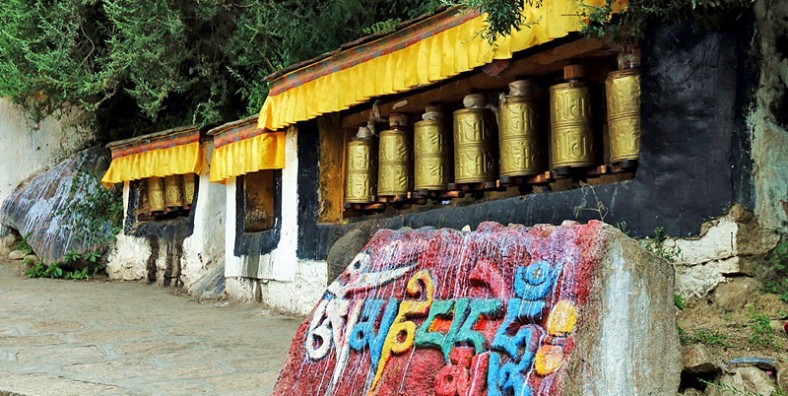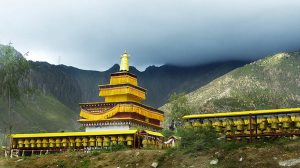
6 Days Shoton Festival Experience Tour

Tour Overview
This Tibet Festival Tour will take you to experience the grandest festival to Tibetans – Shoton Festival. It starts on the last day of the sixth month in Tibetan...
Code of Tour: YCT0000003183
Length of Travel: 6 Day
Destinations of Tour: Lhasa
Departure City: Lhasa
Price of Tour: Request
Type of Tour:
Features of Tour: Nature Culture Minority Landscape
This Tibet Festival Tour will take you to experience the grandest festival to Tibetans – Shoton Festival. It starts on the last day of the sixth month in Tibetan Calendar and lasts for a few days. During this festival, you will enjoy a big feast of Tibetan performances, Tibetan Buddhist activities and Tibetan food. The grandest activity is held in Lhasa. Tourists can see a lot of Lamas in Drepung Monastery spreading out the giant “Thanka” of Buddha, and performing wonderful Tibetan operas in Norbulingka. Monasteries will also hold various solemn chanting activities, and people throughout the city will turn out to worship holy monasteries and have lingka (lingka literally means picnic) in park or suburbs, which lasts for a week. Summer is also the best season in grassland, and never miss the Namtso Lake and Nagqu grassland, approximately 5 or 6 hours drive from Lhasa.
Highlights:
- Take part in the grandest festival in Tibet-the Shoton Festival.
- Experience Tibetan Buddhism in significant monasteries in Lhasa city and along the way.
- Meet the tranquil lakes, white snow mounatians, shimmering rivers and rare animals in Lhasa.
- Enjoy the starry sky of the heavenly Namtso Lake.
Brief Itinerary
- Day 1: Lhasa Arrival
- Day 2: Lhasa
- Day 3: Lhasa
- Day 4: Lhasa-Namtso
- Day 5: Namtso-Lhasa
- Day 6: Lhasa Departure
Google Map
Detailed Itinerary
Day 1 Arrive in Lhasa
Sightseeing and Activities:Arrive in Lhasa
Accommodation:Lhasa
Meals:None
When you arrive in Lhasa either by train or flight, your guide will greet you and take you to your hotel .An route to view the Yarlung Tsangpo River/ Bhamaputra river (the Longest and largest river in Tibet) and Lhasa river.
After arriving in Lhasa ,you can take a rest and acclimatize to plateau environment. If you feel to go out, then you can go to the Potala square, where you will enjoy the fountain with different colors and get amazing photos of the Potala and around. Stay overnight in Lhasa.
Day 2 Lhasa
Sightseeing and Activities:Potala Place, Johkang Temple, Barkor Street
Accommodation:Lhasa
Meals:Breakfast, Lunch
Today’s tour will first bring you to the Potala Palace which is the winter palace of the Dalai lama. It was put to use since the 7th Century by the 33rd great king of Tibet. The most valuable collections of Potala Palace are the gilded burial stupas of former Dalai Lamas and meditation Cave of the 33rd great king of Tibet.
Then after lunch, tourists head to Jokhang Temple which was founded by the 33rd great king of Tibet in the 7th century, in order to promote the Buddhist religion. Inside you can see the statue of Buddha Sakyamuni at the age of twelve, perhaps the only most venerated object in Tibetan Buddhism. Around the temple is Barkhor Street, where you can do kora (a religious circle of a building or mountain) with pilgrims and locals, in the meantime you can buy some souvenirs. Stay overnight in Lhasa.
Day 3 Lhasa
Sightseeing and Activities:Watch Buddha Exhibition in Drepung Monastery and Tibetan Opera in Norbulingka
Accommodation:Lhasa
Meals:Breakfast, Lunch

On the first day of the festival is to watch the Buddha Thangka unfolding at the Drepung Monastery. At dawn, a lot of Lamas of Drepung Monastery spread out the giant “Thanka” of Buddha. While Lamas read the scripture and pray, disciples present Khada to the “Thangka”, and touch the “Thangka” by forehead to show their devotion.
Professional and amateur Tibetan opera troupes annually gather in the Norbulingka Palace and perform various Tibetan operas. Along with the Tibetan operas and other religious activities, visitors can also watch yak races, horse races and dancing. Stay overnight in Lhasa
Day 4 Lhasa to Namtso Lake (250km, 5 hours )
Sightseeing and Activities:Lhasa to Namtso Lake (250km, 5 hours )
Accommodation:Namtso Lake
Meals:Breakfast, Lunch
In the morning, drive from Lhasa to Lake Namtso. On the way, you can see Nyenchen Thanglha( snow mountain ranges )and lots of nomads tent with grazing yak and sheep densely-populated around the mountain side. Namtso Lake is the Heavenly lake which is one of the four holy lakes of Tibet and also the highest salt lake. You can do a very relaxing trekking around the lake side and Tashi Island. To spend a night at lake shore is fantastic to see the stars. Stay overnight in Namtso Guest house.
Day 5 Namtso Lake back to Lhasa via Yampachen (230km,5 hours )
Sightseeing and Activities:Namtso Lake back to Lhasa via Yampachen (230km,5 hours )
Accommodation:Lhasa
Meals:Breakfast, Lunch
Enjoy the clear morning at the lake shore, you can trek along the lake shore to Tashi Dor Island to explore the meditation caves. Drive to Dumxung to have lunch.
In the afternoon, you may enjoy Yangpachen Hot Spring (Optional) and have both indoor and outdoor swimming pool filled with hot springs water. Finally, head back to Lhasa. Stay overnight in Lhasa
Day 6 Departure from Lhasa
Sightseeing and Activities:Departure from Lhasa
Accommodation:None
Meals:Breakfast
The guide will transfer you to the airport or train station and help you get on board.
Recommended Hotels
| Destination | 5 Star | 4 Star | 3 Star |
| Lhasa | Luxury St. Regis Lhasa Resort | Lhasa Gang Gyan Hotel | Lhasa Xiongbala Hotel |
Service Included:
-
Tibet travel permit and all other necessary permits to Tibet;
-
All entrance ticket fees for all tourist sites listed in the itinerary;
-
Personal knowledgeable English-speaking Tibetan local tour guide;
-
Personal comfortable, clean and safe vehicle with reliable Tibetan local driver; vehicle ranging from 4WD land cruiser to minibus depending on your group size;
-
All lodging listed in the itinerary; it’s your decision about the accommodation class: luxury 5-star international hotel, comfortable 4-star hotel, economic 3-star hotel or budget hostel, guesthouse or tent. Please tell us your accommodation preference when submitting the enquiry; we will arrange the best-value hotels for you.
-
Domestic flight/train tickets listed in the itinerary;
-
All meals listed in the above itinerary;
Service Excluded:
-
International flight to and out of China;
-
Chinese visa (Note: we could help you with the Chinese visa application, like providing the invitation letter, presenting the hotel or domestic flight reservation copies, etc that you may need. )
-
Domestic flight/train not listed in the itinerary. (We can provide you the domestic flight/train ticket booking service at the BEST discount price; please contact us our travel experts for the details.)
-
Meals not specified in the itinerary; usually it costs about USD3-15 per person for one meal in TAR (Tibet Autonomous Region).
-
Tips and gratitude to tour guide and driver;
-
Personal expenses, like laundry, phone call, snacks, soft drinks (please do the best to avoid the alcoholic beverages during your Tibet trip), optional tour activities, etc.
Travel Tips:
- Tibet Permits
There are several permits required to visit Tibet. Tibet Entry Permit, issued by Tibet Tourism Bureau, is the most important one which has to be obtained before your trip because you must have it to take your flight/train to Tibet. To get the permit, you have to book a Tibet tour with us, and send us your passport and Chinese visa about 20 days in advance, and then let us apply for the permit (all Tibet permits can only be applied by travel agency). If you travel to other prefectures like Shigatse, Nyingchi, Shannan, etc, you also have to obtain an Alien Travel Permit. If you travel to Mount Everest, you have to obtain a Border Permit. (Tibet Discovery, with office in Lhasa, has always kept up with the latest news on Tibet Permits. Traveling with us, all your permits are guaranteed as long as you are qualified to the requirements.)
- Available Months to Visit Tibet
Generally speaking, May to early October is the best time to for a Mount Kailash trip. July and August are the peak season and rainy season. It may be too cold to travel in Kailash area from November to March. There is usually heavy snow. The conditions in Namtso Lake and Mount Everest area are quite similar with Kailash. While other places like Lhasa, Gyantse and Shigatse are suitable for travel all year around.
- High Altitude Sickness
The average altitude of Tibet is about 4000 meters above the sea level (Lhasa: 3700m; EBC: 5200m; Namtso: 4718m). You may suffer a bit from High Altitude Sickness in the beginning days of your Tibet trip if you haven’t had rich high plateau travel experience. But don’t worry too much, the high altitude can be acclimatized usually in 2~3 days. Our suggestion is to take a physical examination and get suggestions from your doctor, and also bring some medicines to prevent from High Altitude Sickness before your trip. While in Tibet, you should keep warm all the time, avoid strenuous activities, drink more water and eat more vegetables and carbohydrates. You’d better not take showers during the first two days after your arrival at Tibet. If you don’t feel well, get help from your tour guide or go to the hospital without any delay.
- How to Go to Tibet
Basically you have two options – flight and train. Currently, you can take a flight to Lhasa from Beijing(4.5hrs), Xian(3.7hrs), Chengdu(2.5hrs), Chongqing(3hrs), Kuming(3hrs), etc. Among all these cities, Chengdu and Xian have more frequent flights to Lhasa. Kathmandu also has several flights to Lhasa each week.
If you a train travel, you can take a train to from Beijing(40.5hrs), Xian(32hrs), Chengdu(43hrs), Shanghai(47hrs), Chongqing(42hrs), Lanzhou(25hrs), Xining(22hrs), Guangzhou(54hrs).
- Packing and Wearing Ideas
Firstly you can’t forget your passport and Chinese Visa. A large backpack and a smaller one are recommended (the smaller one can be used for daily activities). Also bring the necessary medicine you need. Other stuffs like sunglasses, snow glasses, hats, lip balm, sun block are recommended. As for wearing, you are suggested to dress in layers (both thin and thick jackets). Down jacket is necessary in Spring and Autumn. A pair of durable and comfortable shoes is necessary.

















